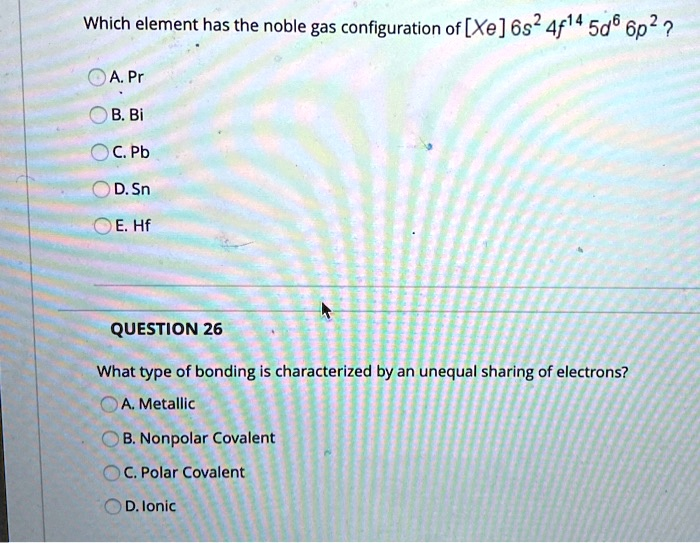Which element has the noble gas configuration of [Xe] 6s2 4f14 5d6 6p2? A. Pr B. Bi C. Pb D. Sn E. Hf QUESTION 26 What type of bonding is characterized by an unequal sharing of electrons? A. Metallic B. Nonpolar Covalent C. Polar Covalent D. Ionic

The Correct Answer and Explanation is:
For the first question, the correct answer is B. Bi (Bismuth).
Let’s break it down: the electron configuration [Xe] 6s² 4f¹⁴ 5d⁶ 6p² corresponds to an atom with 83 electrons. Starting from the xenon core (which accounts for 54 electrons), adding 2 from 6s, 14 from 4f, 6 from 5d, and 2 from 6p gives a total of 54 + 2 + 14 + 6 + 2 = 78 electrons, which is missing 5 electrons. However, because there seems to be a discrepancy in the orbital filling and sequence, we instead rely on identifying the highest principal quantum number orbitals, which are 6s and 6p. The 6p² configuration signifies that the element is in the p-block, and a full 4f orbital indicates it lies beyond the lanthanide series. Bismuth, with atomic number 83, aligns perfectly with this configuration and completes Group 15 in Period 6.
Now for QUESTION 26, the correct choice is C. Polar Covalent.
This type of bonding occurs when atoms share electrons, but the sharing is not even. One atom has a higher tendency to attract the bonding electrons due to its greater electronegativity, so the electrons spend more time closer to that atom. As a result, the molecule has a partial positive end and a partial negative end. A good example is water (H₂O), where the electrons are drawn more toward the oxygen atom, creating a dipole.
This is different from nonpolar covalent bonding, where electrons are shared equally; ionic bonding, where electrons are transferred completely from one atom to another; and metallic bonding, which involves a sea of delocalized electrons among metal atoms. Polar covalent bonds are fundamental to understanding molecular behavior in biological systems, such as enzyme-substrate interactions and cell membrane dynamics.
